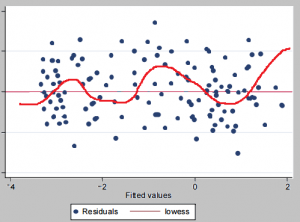Statistics Definitions > Serial Correlation / Autocorrelation
What is Serial Correlation / Autocorrelation?
Serial correlation (also called Autocorrelation) is where error terms in a time series transfer from one period to another. In other words, the error for one time period a is correlated with the error for a subsequent time period b. For example, an underestimate for one quarter’s profits can result in an underestimate of profits for subsequent quarters. This can result in a myriad of problems, including:
- Inefficient Ordinary Least Squares Estimates and any forecast based on those estimates. An efficient estimator gives you the most information about a sample; inefficient estimators can perform well, but require much larger sample sizes to do so.
- Exaggerated goodness of fit (for a time series with positive serial correlation and an independent variable that grows over time).
- Standard errors that are too small (for a time series with positive serial correlation and an independent variable that grows over time).
- T-statistics that are too large.
- False positives for significant regression coefficients. In other words, a regression coefficient appears to be statistically significant when it is not.
Types of Autocorrelation
The most common form of autocorrelation is first-order serial correlation, which can either be positive or negative.
- Positive serial correlation is where a positive error in one period carries over into a positive error for the following period.
- Negative serial correlation is where a negative error in one period carries over into a negative error for the following period.
Second-order serial correlation is where an error affects data two time periods later. This can happen when your data has seasonality. Orders higher than second-order do happen, but they are rare.
Testing for Autocorrelation
You can test for autocorrelation with:
- A plot of residuals. Plot et against t and look for clusters of successive residuals on one side of the zero line. You can also try adding a Lowess line, as in the image below.
- A Durbin-Watson test.
- A Lagrange Multiplier Test.
- Ljung Box Test.
- A correlogram. A pattern in the results is an indication for autocorrelation. Any values above zero should be looked at with suspicion.
- The Moran’s I statistic, which is similar to a correlation coefficient.
